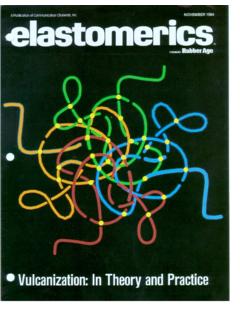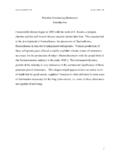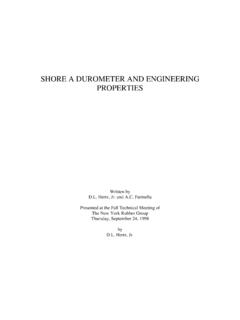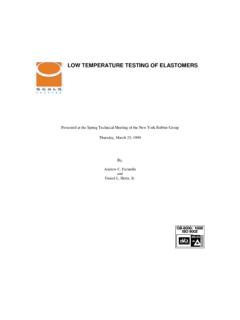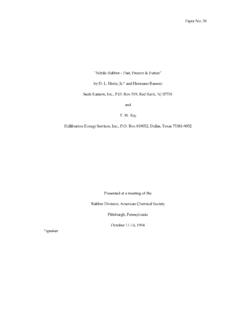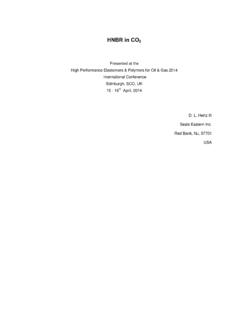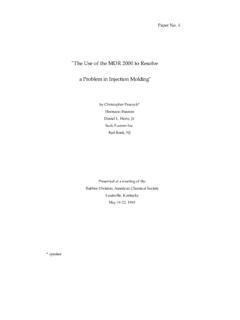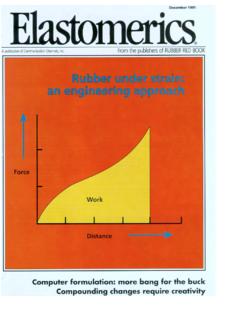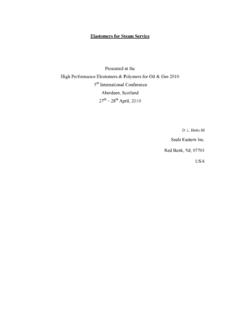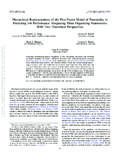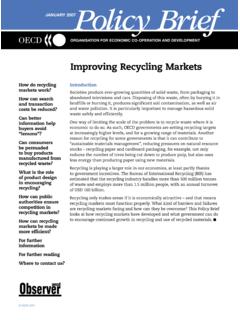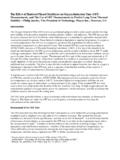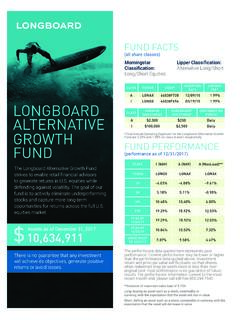Transcription of SOLUBILITY PARAMETER CONCEPTS - A NEW LOOK*
1 Paper No. 36 SOLUBILITY PARAMETER CONCEPTS -A NEW LOOK* Daniel L. Hertz, Eastern, Inc. +Red Bank, NJ 07701-0519* Presented at a meeting of the Rubber Division, American ChemicalSociety, Mexico City, May 9-12, 1989+ Contribution No. 36 2 INTRODUCTIONThe SOLUBILITY PARAMETER concept , on first discovery appears tooffer a rationalized approach for a simplified elastomer selection invarious solvents. The original definitive book, " SOLUBILITY ofNonelectrolytes"' by the title gives the first clue that the problem ismore complex than the simple "likes dissolves likes" approach. We livein a world of aqueous and nonaqueous electrolytes. Barton's recentwork, "Handbook of SOLUBILITY parameters and Other Cohesion parameters 2 is a good starting point for a serious study. Kamlet et a13offer somenewer thoughts on SOLUBILITY including more recent references.
2 Jensen4 in a recent chapter correctly notes that most of the solubilityparameter CONCEPTS use the historic "similarity matching" of propertiesrather than the more appropriate "complementary matching" ofproperties. The former approach still pervades "as a result of aninappropriate extension of the dispersion-only arguments used in theoriginal theory of regular solutions." Consider now, three examples ofa mixed-solvent mixtures are more often the rule rather than theexception; non-latex paints, lacquers, gasohol. Less obvious is highpressure sour gas (a mixture of methane, carbon dioxide and hydrogensulfide). Consider first, a typical high molecular weight polymersuitable as a paint, lacquer or ink. The following solvents might beutilized to create a solution-based product: 3a. Theta solvent (one that dissolves the elastomer withthe solvated macromolecule size corresponding to it'sunperturbed [bulk] dimension).
3 This solvent category isnecessary to develop high % solids while maintaining Diluent solvent (one compatible with the theta solvent butincompatible with the polymer).c. Viscosity control solvent (a high volatility solvent toreduce overall viscosity for spray painting - typicallyevaporates before the paint or lacquer coats the object).d. Evaporation rate solvent - a low molecular weight, lowvolatility film-forming (leveling) solvent that allowssolvents "a" and "b" to evaporate without forming a hard filmfirst. This is necessary to develop a glossy Plasticizer solvent - develops flexibility in the typical range of solvents in a polymer based lacquersystem could be:A. tetrahydrofuran (theta solvent)B. ketone (diluent)C. aromatic hydrocarbon (viscosity control)D. glycol ether (evaporation rate control)E. phthalate ester plasticizer (flexibilizer)Gasoline-alcohol mixtures, -the second example, are "nonidealsolutions" as indicated by the increase in both volume and bulk 4temperature on mixing.
4 To prevent phase separation during temperatureshifts, a third component such as MTBE (methyl tertbutyl ether) orhigher molecular weight alcohols must be added to couple the twophases. Simplistically the -OH groups have a strong physical attractionto the alcohol and the -R groups are soluble in the gasoline. Thus agasoline-alcohol mixture typically contains:a. hydrocarbon(s)b. alcoholc. ether or higher alcoholThe third case, sour gas is again different, the elevated pressure andtemperature increase the density of the C02and H2S so they have themobility of a gas but the solvent power of liquids, each totallydissimilar in their SOLUBILITY response. The gases are best illustratedby Figure 1 in a molecular thermodynamic sense as:a. methane (octopole)b. carbon dioxide (quadrupole)c. hydrogen sulfide (dipole)RESULTSH ansen and Beerbower5give a brief review suitable for a basicexplanation of the "similarity matching" concept of solubilityparameters.
5 It is less than adequate to develop a reasonableunderstanding of the SOLUBILITY problem as defined in the first examplenoted in the "Experimental" discussion. This equation is simply stating that the heat of vaporization Hv less thevolume work (-RT, where R=gas constant, T=absolute temperature) is theestimate of energy to maintain the liquid state 5 The second example, gasoline-methanol is totally incompatible with theHansen-Beerbower approach. This was noted by Hertz6wherein the effectof gasoline, methanol and their mixtures on a 38% ACN nitrile elastomeris tabulated in Figure third example, -sour gas/elastomer interactions, is based onoriginal data from Ender7. His data, plotted by Hertz8in Table Iindicates a substantially greater swelling than predicted inpropylene-TFE elastomer (AFLAS -ASAHI-3M), as compared to ethylene-propylene elastomer and the perfluoroelastomer (KALREZ -Dupont).
6 Subsequent discussions with Jensen9shed new thoughts on this swellinganomaly. This concept was outlined by Hertz10using Dr. Jensen's majorcontribution of Lewis acid-base considerations as a logical , we will review SOLUBILITY PARAMETER CONCEPTS and commenton them. The basic equation of Hildebrand and Scott designated theenergy of vaporization as thecohesive energy density(ced) and it'ssquare root as thesolubility PARAMETER , ( )thus, 6orcohesive this value by molar volume V corrects fordensity leading to the termcohesive energy values arereported in MPa1/2units. This equation is only suitable for vaporsobeying the ideal gas law ie: nonpolar fluids (nonelectrolytes).An area of somewhat generalized agreement was the considerationthat polar (aqueous and nonaqueous electrolytes) fluids had three majorintermolecular forces to consider:Dispersion (London) forces "D"-common in all cohesive energyHydrogen bonding "H", now referred to as H-bondingDipole moment "P", a measure of thepolar(electrostatic)aspect of a Hansen modification, utilizing these three intermolecularattractions,was intended for polar fluids by assigning a partial solubilityparameter equal to the square root of the corresponding partial cohesiveenergy density.
7 The gasoline-ethanol combination previously noted was anexothermic(gave up heat) mixture. Jensen4 correctly notes that Equation(2) contains only thesquaresof the difference, it can thus only leadto positive orendothermicvalues and is therefore incapable ofpredicting accurately nonideal fluid/elastomer interactions (square oftwonegatives isa positive). This lack of consistency was previouslynoted by Hertz6 The final insult to the classical SOLUBILITY PARAMETER concept is the high pressure sour gas combination noted. Consider the responseof the three elastomers (Table 1):EPDM (nonfluorinated)AFLAS (half-fluorinated EPDM)KALREZ (totally fluorinated EPDM)to very dissimilar gases, CO2and H2S. One might presume AFLAS tohave an intermediate swelling effect somewhere in between EPDM andKALREZ based on the Hansen approach for SOLUBILITY parametercalculation.
8 Table 1 trend lines indicates approximately double(2X) the anticipated TFE/propylene molar ratio is approximately 48/52. Hydrocarbonsrespond to electrophilic reactions while fluorocarbons are dominated bya nucleophilic response. This makes it logical to pursue donor/acceptor(Lewis acid-base) possibilities. Adding to this concept , Jensen4 in hischapter notes that "H-bonding is not really a particular kind ofintermolecular 'force' like a dipole or dispersion force, but rather,as emphasized earlier, an example (albeit, a very important one) of ageneralized electron-pair, donor-acceptor or Lewis acid-baseinteraction". He further notes "that most specific electrostatic orpolar interactions are already included within conventional measures ofelectron-pair donor and acceptor strengths, making the separate polarterm in the equation potentially redundant.
9 " Specifically addressingthe sour gas swelling phenomenon, Prof. Jensen9 states:"Quantifying these considerations is, however, more difficult. 8As most species are to some extent amphoteric and their EPA(electron-pair acceptor) and EPD (electron-pair donor) properties tendto work in opposite directions as far as the sign and magnitude of thezeta ( ) potential are concerned. Perhaps the simplest approach to thisproblem would be to use an empirical linear correlation similar to thatproposed by Koppel and Palm in 1971 to analyze the solvent dependencyof various physico-chemical properties:where P is the value of the property in the solvent of interest, P0 isthe value of the property in some reference state (preferably, but notnecessarily, the gas phase or some inert solvent). describes thesensitivity of the property to solvent basicity, its sensitivity tosolvent acidity, its sensitivity to nonspecific dispersion property in question may be a spectral transition, the logarithm ofa rate constant or an equilibrium constant, a reaction enthalpy, an NMRshift, or, in our case, the zeta ( ) potential of a colloidal if the EPA-EPD character of the solvent is significant, ittends to swamp the last term.
10 "Jensen(18) further suggests the anomalous swelling of AFLAS isexplained in the following manner: 9"The equation of interest is N0. 38: , and are determined by least squares multiple PARAMETER regressionanalysis by measuring P in a variety of systems of known DN, AN and values can then be used to calculate P in other your system:Po = volume swell in air = 0P = volume swell for gas or liquidDN, AN, d= characterize the gas or liquid , & = characterize the polymerFor your gases (these are qualitative guesses): -(H2S>C02)DN - (H2S>C02)AN - (C02>H2S)For your polymers (these are qualitative guesses):EPDM ( = = O re only is operative, polymer is non-specificAFLAS ( and large - and swamp , polymer is amphoteric)KALREZ ( =O, large and swamp , , polymer is a Lewisbase)." 10 CONCLUSIONSE quation (38) offers exciting possibilities for a morerationalized approach using the complementary matching of propertiesfor fluid-elastomer interactions.)

